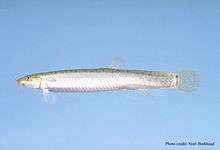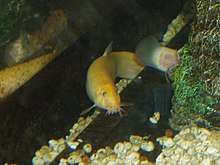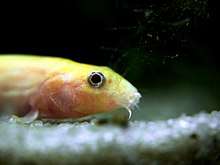Pond loach
The pond loach, (Misgurnus anguillicaudatus), is a freshwater fish in the loach family Cobitidae. They are native to East Asia but are also popular as an aquarium fish and introduced elsewhere in Asia and to Europe, North America and Australia.[1][2] The alternate name weather loach is shared with several other Cobitidae, including the other members of the genus Misgurnus and the spotted weather loach (Cobitis taenia, commonly known as spined loach). This term comes from their ability to detect changes in barometric pressure and react with frantic swimming or standing on end. This is because before a storm the barometric pressure changes, and this is known to make these fish more active. The pond loach also comes in a variety of colors, such as pink, orange, albino and gray. The largest dojo loach raised in an aquarium recorded was recently discovered in a Nova Scotian home measuring at 8.46 Inches long.
| Pond loach | |
|---|---|
 | |
| Scientific classification | |
| Kingdom: | Animalia |
| Phylum: | Chordata |
| Class: | Actinopterygii |
| Order: | Cypriniformes |
| Family: | Cobitidae |
| Genus: | Misgurnus |
| Species: | M. anguillicaudatus |
| Binomial name | |
| Misgurnus anguillicaudatus (Cantor, 1842) | |
| Synonyms | |
| |
Description
Like many other loaches, pond loaches are slender and eel-like. They can vary in colour from yellow to olive green, to a common light brown or grey with lighter undersides. The mouth of the loach is surrounded by three sets of barbels. It uses them to sift through silt or pebbles to find food. It also uses them to dig under gravel and sand to conceal itself out of nervousness or defence unlike the other loaches who use the spines beneath the eyes. Unlike most other fishes, the Pond loach has the ability to burrow into and hide in soft substrates, breathe in atmospheric air if deemed necessary, as well as survive for long periods of time outside of water.[3]
They can grow up to 12 inches (30.5 cm) long. The fish are bottom-dwelling scavengers, feeding mainly on organic material such as algae. Pond loaches are omnivorous and may also feed on tubifex worms and other small aquatic organisms. By producing a layer of mucus to keep themselves damp they can survive short periods of desiccation. They are very hardy fish that can live in poor quality water.
In the aquarium



Pond loaches are active, peaceful, and hardy fish that are sometimes used as starter fish in an aquarium. They can be "friendly" towards humans, allowing physical contact and hand feeding. They are extremely peaceful. They get along well with goldfish.
The loaches will be more active given more space and greater numbers. Solitary pond loaches tend to spend much of their time hiding. They will spend a lot of time hiding or staying still, but should be given a place to stay which will have cover and shade. Tank decorations that they can swim through and driftwood both work great for this. Due to their jumping ability the average cover should be secured with tape or other barriers. Also, they may even travel up tubes and take up residence in filters, so check there if your pond loach does not show up for roll call one day. Pond loaches enjoy digging and burrowing themselves in the substrate of their tank, so make sure that your substrate is fine enough for them to dig in. If you keep live plants in your tank, they will be uprooted by the loaches, so it is a good idea to weight your plants. The pond loach is also peculiar in that it will sometimes bury itself in the substrate during times of stress. This often surprises new owners, as the fish will "disappear" shortly after introduction to the tank only to "reappear" later.
Because of their appetite for snails, these loaches can help alleviate snail infestations in tropical fish tanks, though many have reported that while pond loaches do eat snails, they do not eat them at a fast enough rate to deal with an infestation.
The fish prefer a pH of 6.5-8.0 but will tolerate far more acidic conditions even for extended amounts of time with little negative reaction. This makes the pond loach a great choice for first-time aquariums and for those who want a hardy fish tank able to withstand a few mistakes. This fish should be kept in groups of at least 3, as they like to be in physical contact with each other and feel each other with their barbels when they rest.
One trait which distinguishes the pond loach from most other tropical fish commonly seen at aquarium speciality shops and pet stores is the fact that they thrive at room temperature (68-72°F, 20-23°C) and can do well even at temperatures as low as the upper 50's Fahrenheit (13-15° Celsius). The usual tropical temperature will result in a significantly reduced lifespan (from an average 10 years to four or less). Purchasers often presume when buying tropical freshwater fish that all species will thrive in the (typical for home freshwater aquarium installations) 76-82 °F / 24-28 °C range; this presumption is incorrect in the case of the pond loach.
There are other varieties bred from captivity like the gold strain and the peppered strain (not to be confused with the pepper loach). Sometimes the pond loach (especially the golden variety) is mistaken for the kuhli loach. The kuhli, however, likes warm tropical temperatures, will tolerate more acidic conditions, and matures at a much smaller four inches (10 cm). Although these two species have numerous differentiating traits, individual kuhli and pond loaches may resemble each other while young and at the usual age and size of what most fish stores market.
As food
The pond loach is a common culinary fish in East Asia, raised on a large scale in fish farming.
In Korea, chueo-tang (loach soup) is made with pond loach.
See also
- Loach
- European weather loach
- Dojō nabe
References
- Zhao, H. (2012). "Misgurnus anguillicaudatus". IUCN Red List of Threatened Species. 2012: e.T166158A1115635. doi:10.2305/IUCN.UK.2012-1.RLTS.T166158A1115635.en.
- Juddery, Bruce (26 July 1994). "Tough Asian fish a great survivor". The Canberra Times. p. 10.
- Belcik, J. (2017). Population Genetics and Distribution of the Oriental Weatherfish, Misgurnus anguillicaudatus, in Chicago Area Waterways. Retrieved April 4, 2019, from https://ecommons.luc.edu/luc_theses/3556/
Bibliography
- "Misgurnus anguillicaudatus". Integrated Taxonomic Information System. Retrieved 30 January 2006.
- Froese, Rainer and Pauly, Daniel, eds. (2005). "Misgurnus anguillicaudatus" in FishBase. 10 2005 version.
- How to Keep Your New Weather Loach
- "New Invasive Fish Spreads Through The Ebro Delta". Science News. Science Daily. 2009-01-20. Retrieved 2009-01-20.
- Franch, Nati; Clavero, Miguel; Garrido, Montse; Gaya, Norbert; Lopez, Veronica; Pou-Rovira, Quim; Maria Queral, Josep (2008). "On the establishment and range expansion of oriental weatherfish (Misgurnus anguillicaudatus) in NE Iberian Peninsula". Biological Invasions. 10 (8): 1327. doi:10.1007/s10530-007-9207-9. hdl:10261/46169.
